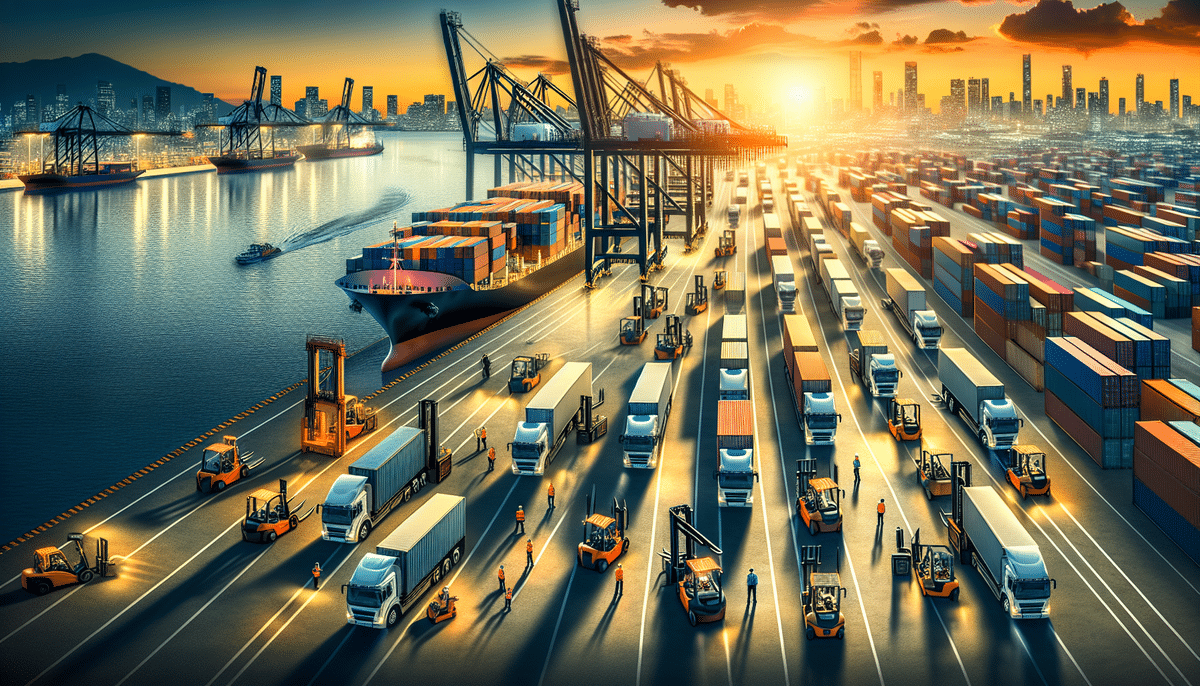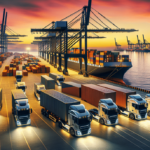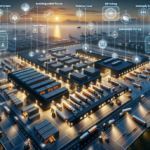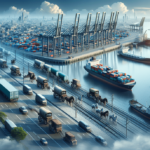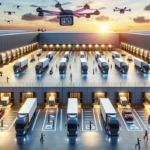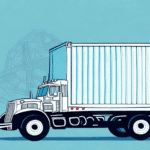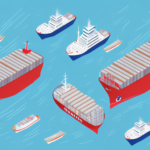What Is Drayage and How Can It Benefit Your Business?
If you are in the world of logistics and transportation, you have probably come across the term drayage. But what exactly does it mean? Drayage refers to the short-distance transportation of goods between a port, rail yard, or warehouse, and a local distribution center or final destination. It plays a crucial role in the global supply chain, facilitating the movement of cargo from one mode of transportation to another and ensuring timely delivery to the end user. In this article, we will explore the history, benefits, challenges, and future of drayage, and why outsourcing drayage services can enhance your business operations.
The History of Drayage: From Horse-Drawn Carriages to Modern Transportation
The origins of drayage can be traced back to the early 19th century, when horse-drawn carriages were used to move goods from the docks to nearby warehouses in bustling port cities such as London and New York. As transportation technology evolved, so did the drayage industry. The invention of the steam engine and the railroad in the mid-19th century revolutionized the movement of cargo, and drayage trucks emerged as a more efficient means of transporting goods from the rail yards to local markets.
In the 20th century, the drayage industry boomed alongside the growth of international trade and the advent of containerization. Today, drayage companies operate a diverse fleet of vehicles, including trucks, tractors, chassis, and trailers, equipped with advanced technologies such as GPS tracking and electronic logging devices (ELDs). According to the 2023 Global Drayage Report, the adoption of these technologies has increased operational efficiency by 25% over the past year.
Understanding the Role of Drayage in the Supply Chain
Drayage is an essential link in the supply chain, connecting the various nodes of global trade and ensuring that cargo flows smoothly and efficiently. When cargo arrives at a port or rail yard, it needs to be transferred to a local distribution center or warehouse for further processing and distribution. This is where drayage comes in, providing the crucial last-mile delivery from the port to the final destination.
Drayage companies are also responsible for complying with complex regulations and requirements, such as safety and environmental standards, customs clearance, and port fees. According to the Federal Motor Carrier Safety Administration (FMCSA), compliance with these regulations is critical to avoid costly fines and ensure smooth operations.
In addition, drayage plays a vital role in congestion management and reducing the carbon footprint of transportation by optimizing routes, reducing idle time, and promoting sustainable practices. A study by the Environmental Protection Agency (EPA) found that optimized drayage operations can reduce fuel consumption by up to 15% and emissions by 10%.
The Benefits of Outsourcing Drayage Services for Your Business
Outsourcing drayage services can bring many benefits to your business, including cost savings, efficiency gains, and improved compliance and risk management. By partnering with a reliable drayage provider, you can leverage their expertise, infrastructure, and network to streamline your logistics operations and focus on your core business.
Drayage companies can also offer value-added services such as warehousing, cross-docking, and inventory management, allowing you to optimize your supply chain and respond flexibly to changing market demands. Moreover, outsourcing drayage can help you mitigate risks associated with regulatory compliance, driver shortages, and insurance liability, as drayage providers are subject to stringent safety and environmental standards and have insurance coverage for accidents and damages.
According to ShipScience's 2023 Business Insights, businesses that outsource drayage services report an average of 20% reduction in logistics costs and a 30% improvement in delivery times.
Choosing the Right Drayage Provider: Factors to Consider
When selecting a drayage provider for your business, there are several factors you should consider to ensure that you make the best choice:
- Experience and Reputation: Evaluate their credentials, reviews, and customer feedback to ensure reliability and expertise.
- Capacity and Capabilities: Assess the size, age, and condition of their fleet, the availability of drivers and equipment, and their coverage area and destinations.
- Rates and Fees: Compare their rates and fees, and negotiate a clear and transparent contract that covers all aspects of the service, including delivery times, liability, insurance, and dispute resolution.
- Regulatory Compliance: Ensure they comply with safety and environmental regulations, such as FMCSA rules, California Air Resources Board (CARB) regulations, and Occupational Safety and Health Administration (OSHA) guidelines.
- Technology and Communication: Review their technology and communication tools, such as dispatch systems, tracking apps, and customer portals, to ensure real-time visibility and control over your shipments.
For more detailed guidelines, refer to the ShipScience Guide to Selecting a Drayage Provider.
How Technology is Revolutionizing Drayage Operations
Technology is transforming every aspect of the drayage industry, from fleet management and driver safety to cargo tracking and customer service. The use of digital platforms and apps has made it easier for drayage companies to connect with shippers, brokers, and carriers, and streamline their operations.
For example, electronic logging devices (ELDs) have improved compliance with hours-of-service regulations, reduced paperwork, and enhanced driver safety. GPS tracking and telematics systems have enabled real-time visibility and accuracy of location, speed, and fuel consumption. Automated gate systems and appointment scheduling have reduced waiting times and congestion at ports and terminals.
Additionally, the use of analytics and artificial intelligence (AI) has enabled drayage companies to optimize their routes, reduce empty miles and fuel consumption, and predict demand and supply fluctuations. According to a 2023 Technology Trends Report, AI-driven route optimization can increase operational efficiency by up to 18%.
Overall, technology has made drayage more efficient, productive, and sustainable, and has opened up new opportunities for innovation and growth.
Common Challenges Faced by Drayage Companies and How to Overcome Them
Like any industry, drayage faces various challenges that can impact its competitiveness and profitability. Some of the most common challenges include:
- Driver Shortage: The logistics industry continues to face a shortage of qualified drivers, impacting delivery times and operational costs.
- Congestion and Delays: Ports and terminals often experience congestion and delays, affecting the timely movement of cargo.
- High Operating Costs: Rising fuel prices, maintenance costs, and regulatory compliance add to the financial burden.
- Safety and Environmental Regulations: Compliance with stringent safety and environmental standards requires continuous investment and adaptation.
To overcome these challenges, drayage companies need to adopt a proactive and strategic approach focusing on innovation, collaboration, and sustainability:
- Driver Training and Retention: Invest in comprehensive training programs and offer competitive benefits to retain skilled drivers.
- Flexible Scheduling Systems: Implement dynamic scheduling systems to adapt to fluctuating demand and reduce idle times.
- Route and Equipment Optimization: Use advanced software to optimize routes and improve equipment utilization.
- Sustainable Practices: Adopt alternative fuels and electric vehicles to reduce emissions and lower fuel costs.
- Collaborative Partnerships: Work closely with customers and stakeholders to enhance supply chain efficiency and resilience.
For more strategies, visit the ShipScience Solutions for Drayage Challenges.
The Future of Drayage: Trends and Predictions for the Industry
The drayage industry is expected to undergo significant changes and seize new opportunities in the coming years, driven by technological, economic, and environmental factors. Key trends and predictions include:
- Increased Adoption of Autonomous and Electric Trucks: These technologies can reduce fuel costs, emissions, and driver fatigue, and improve safety and efficiency.
- Expansion into New Regions and Industries: Growth in sectors such as e-commerce, food and beverage, and healthcare will drive demand for drayage services.
- Consolidation and Collaboration: Mergers, acquisitions, and partnerships among drayage companies and other logistics providers will enhance service offerings and market reach.
- Emergence of New Business Models and Platforms: Innovative models leveraging technology and data will optimize pricing, routing, and capacity utilization.
- Focus on Sustainability: Increasing emphasis on environmental responsibility will drive the adoption of cleaner and greener transportation solutions.
Overall, the future of drayage looks promising, provided that the industry adapts to changing market dynamics and embraces innovation, collaboration, and sustainability. For an in-depth analysis, refer to the ShipScience Future Trends Report.
Sustainable Drayage Practices: Reducing Your Business' Carbon Footprint
As businesses strive to reduce their carbon footprint and improve their sustainability profile, drayage can play a key role in achieving these goals. By adopting sustainable drayage practices, such as using alternative fuels, optimizing routes and equipment, and minimizing waste and emissions, businesses can not only reduce their environmental impact but also enhance their reputation, attract new customers, and comply with regulatory requirements.
Some sustainable drayage practices that businesses can implement include:
- Use of Alternative Fuels: Transitioning to natural gas, biodiesel, or electric vehicles to power fleets.
- Idle Reduction Technologies: Implementing automatic engine shut-off and auxiliary power units (APUs) to minimize fuel consumption during idle periods.
- Route Optimization Software: Utilizing software to plan the most efficient routes, reducing fuel consumption and idle time.
- Participation in Green Programs: Engaging in initiatives like the SmartWay Transport Partnership and the Clean Truck Program to promote sustainability.
- Investment in Renewable Energy: Installing solar panels and using energy-efficient lighting to support logistics operations.
By incorporating these sustainable drayage practices into their logistics strategy, businesses can not only save costs but also contribute to a cleaner and healthier planet. For more information on sustainable drayage, visit the ShipScience Sustainability Hub.
Case Studies: Real-Life Examples of Successful Drayage Implementation in Businesses
To illustrate how drayage can benefit businesses of all sizes and types, we present two case studies of companies that have successfully implemented drayage in their logistics operations:
Case Study 1: Edible Arrangements
Edible Arrangements, a popular gift service that sells fruit bouquets online and in-store, faced a challenge with its distribution network, as it needed to transport fragile and perishable items from the warehouse to store locations in a timely and cost-effective manner. By partnering with a drayage provider, Edible Arrangements was able to leverage their expertise in handling delicate goods and their network of local drivers to optimize the delivery process.
The drayage provider offered features such as refrigerated trucks, real-time tracking, and route optimization, ensuring that the products arrived fresh and intact at the stores. As a result, Edible Arrangements was able to improve customer satisfaction, reduce delivery costs by 15%, and expand its network to new locations.
Case Study 2: NIKE
NIKE, a global leader in athletic apparel and footwear, faced a challenge with its sustainability goals, needing to reduce its carbon footprint and comply with environmental regulations without compromising supply chain efficiency and profitability. By partnering with a drayage provider that specializes in green logistics, NIKE achieved its goals by adopting a range of sustainable practices.
The drayage provider utilized electric and hybrid trucks, monitored fuel consumption and emissions, and incentivized drivers to reduce idling and speed. Additionally, the provider enabled NIKE to offset carbon emissions through programs like tree planting and renewable energy projects. Consequently, NIKE enhanced its brand image, attracted new environmentally-conscious customers, and reduced operational costs by 12%.
Conclusion
In conclusion, drayage is a vital and dynamic industry that plays a crucial role in the global supply chain. By leveraging its history, benefits, challenges, and future opportunities, businesses can enhance their logistics operations, improve their sustainability profile, and achieve their business goals. Whether you are a small retailer, an e-commerce giant, or a multinational corporation, outsourcing drayage services can bring many advantages, such as cost savings, efficiency gains, and improved compliance and risk management.
By choosing the right drayage provider, implementing sustainable practices, and adapting to changing market dynamics, businesses can thrive and succeed in the world of logistics and transportation. For expert drayage solutions tailored to your business needs, visit ShipScience.













